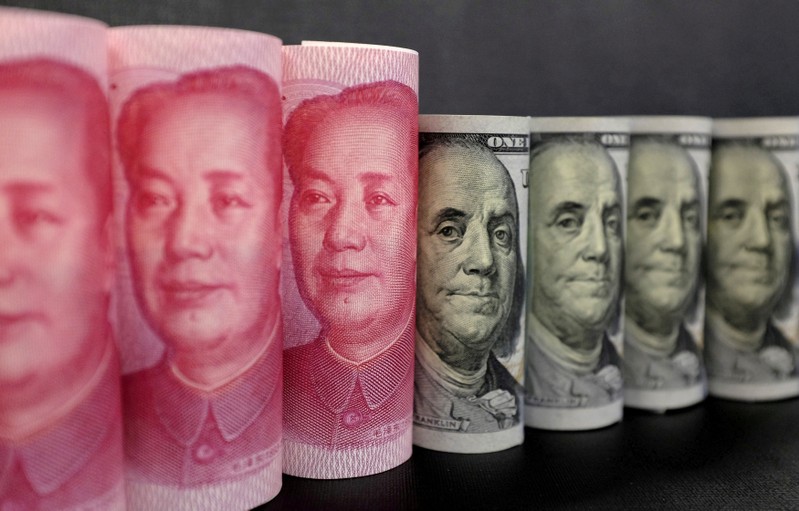
FILE PHOTO: U.S. 100 dollar banknotes and Chinese 100 yuan banknotes are seen in this picture illustration in Beijing, China, January 21, 2016. REUTERS/Jason Lee/Illustration/File Photo
October 8, 2018
By Wayne Cole
SYDNEY (Reuters) – The dollar edged higher on Monday as China followed an easing in domestic policy by allowing its yuan to fall, though the drop was not as sharp as some had feared.
Moves were limited by a lack of liquidity with Japan on holiday and the U.S. bond market on a break. A sudden and steep rise in Treasury yields had underpinned the dollar for much of last week.
China’s central bank moved on Sunday to support the economy by slashing the level of cash that banks must hold as reserves. It was the fourth cut this year and comes as the economy struggles with the drag from an escalating trade dispute with the United States.
Beijing followed by setting its yuan at 6.8957 per dollar <CNY=CNFX>, the lowest since May last year but still short of the psychological 6.9000 level that dealers had eyed.
The fix left the dollar trading at 6.9056 in the spot market <CNH=>, but off an early top of 6.9157.
“China’s latest reserve cut is another step to try to support the domestic economy, amid the headwinds from the trade tensions,” said Westpac strategist Frances Cheung.
“Yet while the cut may help Chinese government bond yields hover around low levels in the face of higher U.S. yields, it also puts upward pressure on USD/CNY.”
Any drop in the yuan tends to undermine other emerging currencies as they need to depreciate to keep exports competitive. That in turn supports the safe-haven yen and the dollar, particularly when U.S. yields are rising.
Yields on 10-year Treasuries <US10YT=RR> hit a seven-year peak on Friday as data showed the unemployment rate falling to its lowest since 1969.
“The employment report does not offer any reason to think the labor market is losing any momentum,” Kevin Cummins, a senior U.S. economist at NatWest Markets.
“As a result, the Federal Reserve’s plan for gradual rate hikes through year end and beyond should remain largely intact.”
Against a basket of currencies, the dollar was a fraction firmer at 95.682 <.DXY> after hitting a six-week top at 96.121 last week.
The dollar inched ahead to 113.90 yen <JPY=> after topping out at 114.55 last week, the highest since November last year. Chart resistance around 114.70/75 remains a major barrier.
The euro hovered at $1.1520 <EUR=>, having bounced only modestly from its recent six-week trough at $1.1462.
Italian politics remained a drag as the European Commission warned the country’s budget deficit breached past commitments, leading Rome to insist it would “not retreat” from its spending plans.
Sterling held at $1.3120 <GBP=> amid speculation Britain was moving nearer to an exit deal with the European Union.
EU Brexit negotiators believe a deal with Britain on leaving the bloc is “very close”, sources said, in a sign a compromise on a major sticking point – the future Irish border – might be in the making.
Brazil’s real was a shade firmer at 3.8364 per dollar <BRL=> after polls in the Presidential election showed right-wing Congressman Jair Bolsonaro was heading toward a second-round runoff against leftist Fernando Haddad.
(Reporting by Wayne Cole; editing by Richard Pullin and Eric Meijer)

